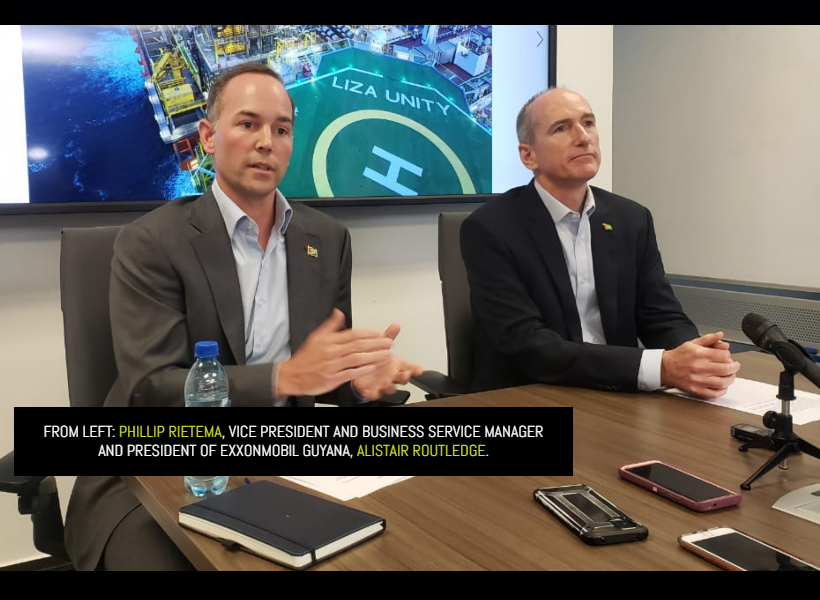Top officials at ExxonMobil Guyana faced the media today to set the record straight on a number of distorted positions being peddled in the raging public debate about its fiscal capacity to address oil spill costs in the Stabroek Block.
President of ExxonMobil Guyana, Alistair Routledge, and Phillip Rietema, Vice President and Business Service Manager said during a press conference at their Kingston office that the company has more than US$21B to deploy for oil spill coverage. They insisted that this is in keeping with international standards as well as the requirements of the Liza Phase One Environmental Permit.
Both executives expressed disappointment with a recent court ruling by Justice Sandil Kissoon ordering an unlimited parent guarantee for the Liza One project by June 10 or have the permit suspended. They said this ruling was appealed by the company for if it is allowed to go through, it would have a significant impact on its revenues. Rietema noted that the monthly loss could be as much as US$350M.
Even as they expressed their disagreement with the ruling, the officials argued that the company has some of the most rigid standards in place to firstly prevent and mitigate a spill before one can even require massive amounts of money for a cleanup.
Expounding on this front, Routledge said, “Under our very clear obligations in the environmental permit from the Environmental Protection Agency (EPA), we have an obligation to prevent oil spill instances from happening, and if they happen, to bear the costs of cleanup and any liabilities that go with that. But let’s first be clear that our absolute commitment is to prevent an oil spill from happening.”
Routledge noted that his company utilizes the latest technologies that assist with the design of the wells which holds the highest risk scenario. He also noted that there is a series of comprehensive procedures that are followed as well as training of personnel in well response, all of which form part of the company’s safety culture.
Should an unmitigated oil spill occur, Routledge said, “We have a whole series of response measures and safeguards.” One of the most significant ones he noted was subscriptions to a capping stack. He noted that this was not available during the tragic Macondo oil spill which saw oil escaping from a deepwater well for 87 days back in 2010 in the Gulf of Mexico.
Routledge said Exxon not only has subscriptions to ensure ease of import but is also required to have one in country. He also shared that the subscriptions allow the oil producer to import and deploy a capping stack to a well blow out in five and a half days. The timeline would be shortened once this equipment gets here next year.
In terms of financial capacity, he assured that the local affiliates of ExxonMobil, CNOOC and Hess Corporation combined have somewhere in the region of US$18B to US$19B of assets on their books.
“So most importantly, if we have to respond, do we have access to funds execute the operations that are needed? Absolutely. We then have the insurance package which is US$600M and which has been in place since the obligation was required and it is in line with industry standard,” Routledge said.
With respect to the financial assurance from ExxonMobil Corporation and the other parent companies, Routledge said this is where it differs with the recent ruling. He said the court is ordering that an unlimited parent guarantee is provided when this is not in keeping with the permit. He argued that provisions of the permit state clearly that there should be an estimate that guides the value of that guarantee. “It is important to have that guide because the permit also goes onto say that it needs to be clear that those affiliated companies have the wherewithal to provide those sums,” Routledge said. He also noted that the documents for the US$2B guarantee are being finalized to be provided to the EPA.
Routledge also informed the media that the US$2B estimate was provided for by an independent estimate. He said it was subjected to a rigourous review by the EPA before approval.
If one takes into consideration the US$19B in assets, the US$2B financial assurance and the US$600M insurance package, Routledge said the company has over US$21B in fiscal coverage. He also noted that as more projects come on board, the company assets will grow, and by extension, the size of the coverage available.













